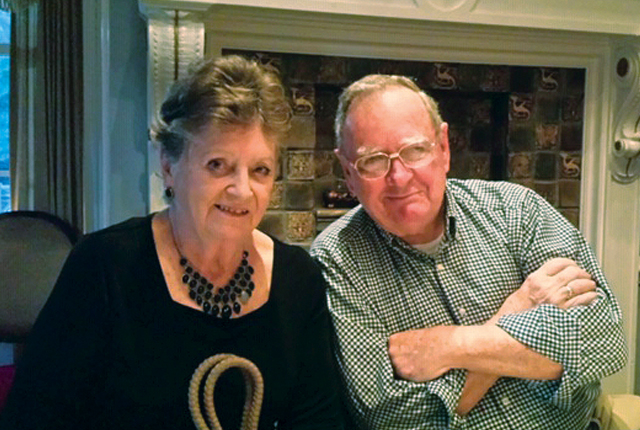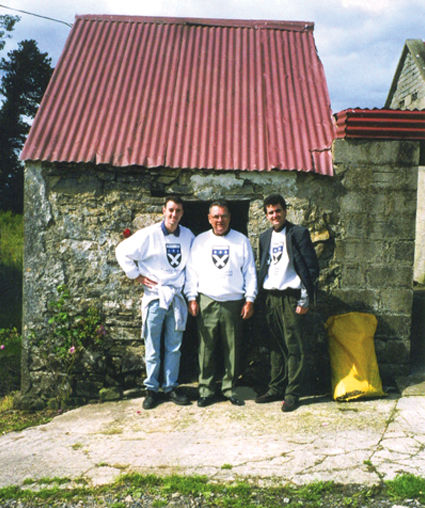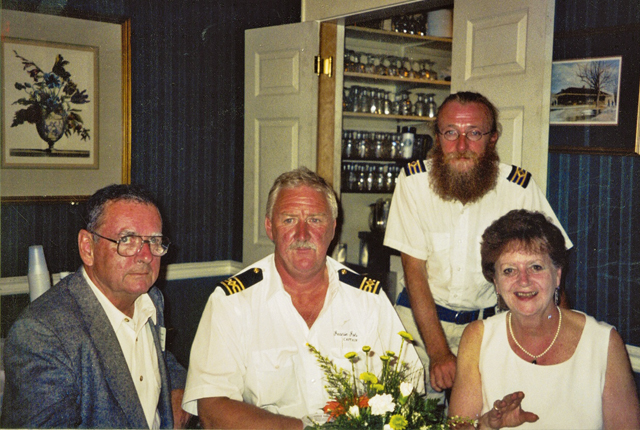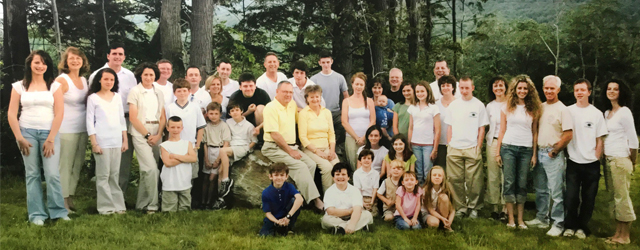By Thom Nickels
(Photo above) Fitzpatrick family: eight children, six spouses and twenty-four grandchildren at family vacation in Vermont, 2006
Where do the people featured on the cover earlier Irish Edition go? Jim Fitzpatrick of Bucks County was featured on the cover of this newspaper in 1990, when he was the grand marshal of the Bucks County Saint Patrick’s Day parade. Since that time his legacy continues to grow.
In fact, the word ‘venerable’ comes to mind when talking with him. During our recent telephone chat he told me that he is father of eight children; that two of his daughters own Irish dancing schools and two of his sons went into politics.

The two political sons, Michael and Brian, were elected to the same office: Republican Congressmen from Pennsylvania’s 1st Congressional District. His eldest, Michael, was inspired to run for office after attending school in Miami where he worked for a Republican Congressional candidate. Jim says that when Michael returned home “he changed everyone in the family from Democrat to Republican except me. He even brought home one of Barry Goldwater’s books for me to read.”
Michael held the 1st Congressional District post for eight years and then decided not to run again because he was a staunch advocate of term limits. “He quit because he didn’t believe that people should be elected for life.”
In a serendipitous twist, after Michael “retired,” Brian Fitzpatrick ran for the same post as a Republican and continues to hold it. “Brian,” Jim says, “also believes that people should do their four terms and then get out.”
Jim, true to his political roots, remained a solid Democrat until 1992 when his hero, former PA Governor Bob Casey was banned from speaking at the Democratic National Convention because of his pro-life views. “Casey was controversial because his philosophy was outside of the Democratic Party in that respect, and when they wouldn’t let him speak, I said to myself. ‘I think I need to get out of this party.’”
“The poor guy [Bob Casey] from then on until his death was a man without a party,” Jim said. “The Democratic party wouldn’t accept him and he didn’t want to become a Republican. He was a great man. He did a tremendous amount of good as governor of Pennsylvania.”
One day Jim got the opportunity to go up to Senator Bob Casey Jr. and tell him what he thought of him. “You are not your father,” he said. The stunned senator, as Jim recalls, didn’t appreciate the remark and asked him why he felt that way.
“I was one of your father’s biggest fans,” he said. “I supported him and worked for him but I left the party—actually the party left me—when the Democrats wouldn’t allow him to speak.’
“Well, a lot of people tell me that,” the senator replied.
Jim will tell you upfront that he is no political ideologue. He firmly believes that “the Democratic party still has some good aspects,” but he’s also quick to tell you that all is not harmonious on the Republican side, either.
“You know, my son Brian, who is the current Congressman, belongs to a bipartisan group called Problem Solvers, and he gets clobbered in this area because he’s not Republican enough. He’s called a Rino, a Republican in name only.”

Jim Fitzpatrick was born in Queens, New York and went to school in Brooklyn. He says that growing up he went to a lot of Yankee and Ranger games. He met his wife, Mary, about a year before he moved to Philadelphia when he was working at Lever Brothers and living in the Bronx. He enlisted in the military from 1954 to 1955 and was stationed in Newfoundland, a beautiful province he describes as “beautiful.”
Because the Korean Conflict was not officially finalized until January 31, 1955, he was still eligible for benefits under the Korean GI Bill and that enabled him to attend La Salle Night School when he moved to Philadelphia.
He talks about his famous first cousin, British actor Patrick McGoohan, star of the once popular TV series The Prisoner. “He was the producer, star and writer,” Jim says. “He did everything for the show. He came to the USA in the 1960s for a TV series called The Secret Agent. He was offered James Bond’s role before anyone else but he didn’t take it because he didn’t like the culture of the show. It was too risqué.”
McGoohan was in many movies, including Mel Gibson’s Braveheart (where he played King Edward I), Ice Station Zebra and many more. “I visited him in England and corresponded with him back and forth, but he was one of 25 or 30 cousins, so I kind of paid attention to the cousins I had in this country than the ones that I had in England,” Jim tells me.
Jim’s father, who died in 1981, migrated to the United States from County Leitrim in Northwestern Ireland. A blacksmith by trade, he had to reinvent himself in New York City so went to work at Con Edison as a mechanic. He also played the violin in Irish dance halls. “That’s probably where my violin playing comes from,” Jim says.
An avid reader, Jim likes the works of Philadelphia’s own Archbishop Chaput, especially when the archbishop writes about religion and politics. He derives a lot of pleasure from reading and mentions the book, “A Pope and a President,” about John Paul II and Ronald Reagan. He says he does a lot of his reading in Florida, where he visits with Mary for six or seven weeks in the winter.
He likes the fact that the Irish Edition started about the same time that he founded the Irish American Cultural Society of Bucks County, which soon became the title of his monthly column in the paper after meeting with editor Jane Duffin. When he was featured on the Irish Edition cover, he says he went out and got a bunch of papers but that only one paper remains today.
In truthful Fitzpatrick fashion, he tells me that sometimes he has difficulty with some of the writers in the newspaper. In smart Fitzpatrick fashion, he would not elaborate.
When summer comes he takes the entire Fitzpatrick clan, including all 24 grandchildren, to Lake George, New York, where the exceptionally close-knit family and relatives from Ireland join in the reunion-vacation.

No story about Jim Fitzpatrick would be complete without a reference to the Jeanie Johnston, the replica ship of the 1847 original that transported Irish immigrants to the states during the great famine. Jim told me about how he helped orchestrate a visit from the Jeanie Johnston in 2003 when it traveled to Florida and then up the East Coast to Philadelphia, Bristol, New York and eventually, Canada.
Jim’s participation in that project contributed to a rousing Bristol success, because the crowds and the celebrations there topped any other celebration on the East Coast.

